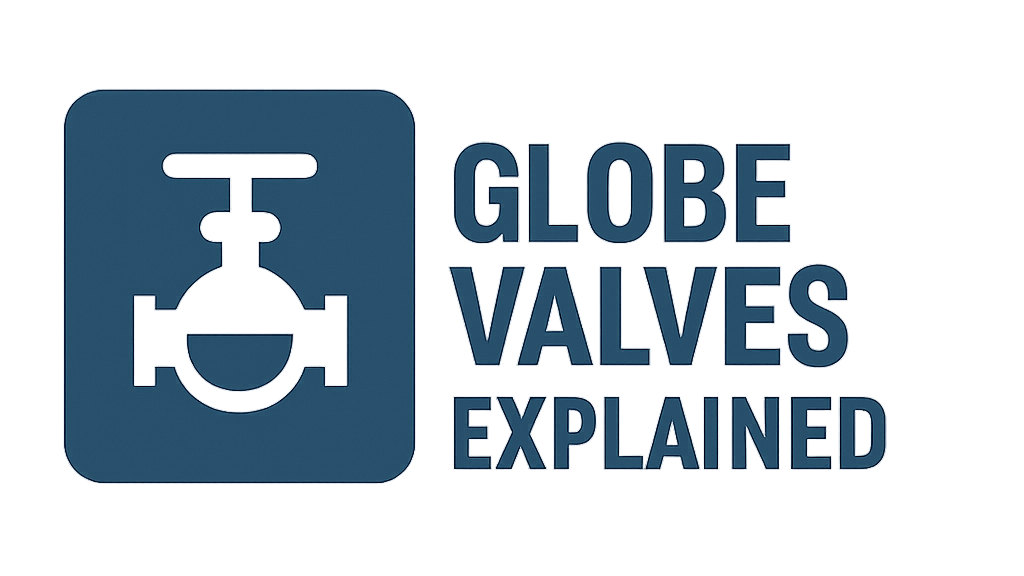Globe Valves Explained
Mastering Flow Regulation and Throttling
Introduction to Globe Valves
Globe valves are linear motion valves primarily designed for stopping, starting, and regulating (throttling) flow in a pipeline. The disc of a globe valve moves perpendicular to the seat, and the S-shaped flow path through the valve body results in a higher pressure drop but allows for precise flow control. They are widely used in applications where flow regulation is critical.
Working Principle: Regulating the Flow
Globe valve operation involves moving a disc relative to a stationary seat:
- Linear Actuation: Turning the handwheel (or actuator) moves the stem up or down.
- Disc Movement: The disc, attached to the stem, moves towards or away from the seat.
- To OPEN, the disc is lifted away from the seat, allowing flow. The extent of opening determines the flow rate.
- To CLOSE, the disc is pressed firmly against the seat, stopping the flow.
- Flow Path: Fluid typically enters below the seat and flows upwards through the seat opening. This S-shaped path causes a change in flow direction and allows for throttling.
The distance the disc moves from the seat directly correlates to the flow rate, enabling precise flow control.
CLOSED
OPEN
Key Components of a Globe Valve
Valve Body
The main pressure boundary, typically globular in shape, containing the seat and guiding the disc.
Bonnet
Covers the valve body, supports the stem and packing, and is usually bolted or screwed to the body.
Disc (Plug)
The closure element that moves against the seat to control flow. Various designs (ball, needle, plug) exist for different flow characteristics.
Stem
Connects the handwheel/actuator to the disc, transmitting linear motion. Usually a rising stem type.
Seat (Seat Ring)
The stationary part of the valve against which the disc seals. Can be integral to the body or a renewable ring.
Handwheel/Actuator
Mechanism for operating the valve. Handwheel for manual control, actuators for automated or remote operation.
Packing
Seals the stem to prevent leakage to the atmosphere. Compressed by a gland follower.
Main Types of Globe Valves
Based on Body Design:
Based on Disc Design:
Actuation Methods
Globe valves require multi-turn linear actuation:
Manual (Handwheel)
Most common. Requires multiple turns to fully open or close.
Electric Actuator
Uses an electric motor for automated or remote control, often with position feedback.
Pneumatic Actuator
Uses compressed air with a diaphragm or piston actuator for linear movement.
Hydraulic Actuator
Uses hydraulic fluid for high thrust requirements, suitable for large or high-pressure valves.
Advantages & Disadvantages
Advantages
- Good throttling and flow regulation capability.
- Accurate flow control.
- Shorter disc travel (stroke) compared to gate valves for on/off.
- Good shutoff capability.
- Easy to machine or resurface seats.
- Can be used as a stop-check valve by modifying the disc.
Disadvantages
- Higher pressure drop compared to gate or ball valves.
- Requires more force or larger actuator to seat the valve against pressure.
- Flow path is not straight, leading to turbulence.
- Heavier than other valves of the same flow rating.
- Can be more expensive for the same flow capacity due to complex body.
Common Materials of Construction
Body & Bonnet
- Bronze, Brass (for smaller sizes, lower pressures, water/steam)
- Cast Iron (e.g., ASTM A126) – general utility service
- Carbon Steel (e.g., ASTM A216 WCB, A105) – wide range of applications
- Stainless Steel (e.g., ASTM A351 CF8M/316, CF8/304) – corrosive fluids, high/low temperatures
- Alloy Steels (e.g., ASTM A217 WC6, WC9, C5, C12) – high temperature, high pressure
Trim (Disc, Stem, Seat Ring)
- Stainless Steel (e.g., 304, 316, 410) – standard trim material
- Stellite® (Cobalt-Chromium alloy) – hardfacing for severe throttling, high temperature, erosion resistance
- Monel® – for specific corrosive services
- Alloy 20 – for highly corrosive applications
- PTFE, PEEK (for disc inserts in composition discs)
Typical Applications
Globe valves are preferred where throttling or frequent operation is needed:
Key Selection Considerations
- Flow Regulation Needs: Primary strength of globe valves. Select disc type accordingly.
- Allowable Pressure Drop: Globe valves inherently have higher pressure drop.
- Fluid Properties: Corrosiveness, temperature, viscosity, presence of solids.
- Operating Pressure & Temperature: Dictates material and pressure class.
- Frequency of Operation: Suitable for frequent cycling and throttling.
- Direction of Flow: Usually installed so pressure is under the disc (helps opening, prevents disc detachment).
- Material Compatibility: Body and trim materials must suit the process fluid.
- Industry Standards: Compliance with API, ASME, ISO standards.
- Shutoff Requirements: Can provide tight shutoff, especially with soft-seated or composition discs.
- Cost & Maintenance: Can be more complex and costly than some other valve types.
Globe Valve vs. Gate & Ball Valves
| Feature | Globe Valve | Gate Valve | Ball Valve |
|---|---|---|---|
| Primary Function | Throttling, On/Off | On/Off (Isolation) | On/Off (Some Throttling) |
| Operation | Multi-turn (Linear) | Multi-turn (Linear) | Quarter-turn (Rotary) |
| Pressure Drop | High | Very Low | Low (Full Port) |
| Throttling Capability | Excellent | Poor | Fair (V-port) to Poor |
| Sealing | Good to Excellent | Good | Excellent (Bubble-tight) |
Precision in Flow Control
Globe valves are indispensable when precise flow regulation and throttling are required. Their design, while leading to a higher pressure drop, offers superior control over fluid flow compared to on/off valves like gate or standard ball valves. With various body and disc designs available, they can be tailored to a wide range of service conditions. Understanding their characteristics is essential for engineers designing systems that demand accurate and reliable flow management.

